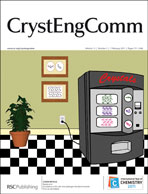The syntheses, characterization and crystal structures of four copper(II)/nickel(II)⋯uranyl(VI) self-assemblies of composition [{NiIIL1}2·{(UVIO2)(NO3)2(H2O)2}] (1), [{CuIIL2}2·{(UVIO2)(NO3)2(H2O)2}]·0.68H2O (2), [{NiIIL2}2·{(UVIO2)(NO3)2(H2O)2}] (3) and [{CuIIL3}·{(UVIO2)(NO3)2(H2O)2}]n (4) are described in this investigation (H2L1, H2L2 and H2L3 are the Schiff base ligands obtained on condensing 3-ethoxysalicylaldehyde with ethylenediamine, o-phenylenediamine and trans-1,2-diaminocyclohexane, respectively). Compounds 1 and 4 crystallized in the monoclinic P21/n and C2/c space groups, respectively, while compounds 2 and 3 crystallized in the triclinic space group P![[1 with combining macron]](https://www.rsc.org/images/entities/char_0031_0304.gif) . Two water molecules of the [(UVIO2)(NO3)2(H2O)2] moiety in 1–4, have a linear H2O–U–OH2 arrangement. Each of these two water molecules in 1–3 interacts with the O(phenoxo)2O(ethoxy)2 compartment of a mononuclear copper(II) or nickel(II) moiety due to the formation of bifurcated hydrogen bonds between each of the two water hydrogen atoms and a pair of one phenoxo and one ethoxy oxygen atoms resulting in the interlinking of the two mononuclear 3d units by the [(UVIO2)(NO3)2(H2O)2] synthon and therefore these three compounds may be considered as supramolecular dimers. Compounds 1–3 are also two component [1 × 2 + 1 × 1] co-crystals consisting of two mononuclear copper(II) or nickel(II) units and one [(UVIO2)(NO3)2(H2O)2] moiety. On the other hand, in 4, two water molecules, from two different [(UVIO2)(NO3)2(H2O)2] moieties, interact with one O(phenoxo)2O(ethoxy)2 compartment resulting in the formation of a self-assembled one-dimensional topology. Again, since one mononuclear copper(II) unit and one [(UVIO2)(NO3)2(H2O)2] moiety exist in a single crystal in 4, this compound is a two component [1 × 1 + 1 × 1] co-crystal. The outcomes of the present study utilize [(UVIO2)(NO3)2(H2O)2] synthon to derive 3d⋯5f co-crystals, provide the first observation of the interaction of two water molecules with one O(phenoxo)2O(ethoxy)2 compartment, demonstrate the formation of supramolecular dimers and show the first example of a one-dimensional self-assembly resulting from water⋯O4 compartment hydrogen bonds, and the first example of [1 × 2 + 1 × 1] co-crystals in 3-ethoxysalicylaldehyde-diamine ligand system.
. Two water molecules of the [(UVIO2)(NO3)2(H2O)2] moiety in 1–4, have a linear H2O–U–OH2 arrangement. Each of these two water molecules in 1–3 interacts with the O(phenoxo)2O(ethoxy)2 compartment of a mononuclear copper(II) or nickel(II) moiety due to the formation of bifurcated hydrogen bonds between each of the two water hydrogen atoms and a pair of one phenoxo and one ethoxy oxygen atoms resulting in the interlinking of the two mononuclear 3d units by the [(UVIO2)(NO3)2(H2O)2] synthon and therefore these three compounds may be considered as supramolecular dimers. Compounds 1–3 are also two component [1 × 2 + 1 × 1] co-crystals consisting of two mononuclear copper(II) or nickel(II) units and one [(UVIO2)(NO3)2(H2O)2] moiety. On the other hand, in 4, two water molecules, from two different [(UVIO2)(NO3)2(H2O)2] moieties, interact with one O(phenoxo)2O(ethoxy)2 compartment resulting in the formation of a self-assembled one-dimensional topology. Again, since one mononuclear copper(II) unit and one [(UVIO2)(NO3)2(H2O)2] moiety exist in a single crystal in 4, this compound is a two component [1 × 1 + 1 × 1] co-crystal. The outcomes of the present study utilize [(UVIO2)(NO3)2(H2O)2] synthon to derive 3d⋯5f co-crystals, provide the first observation of the interaction of two water molecules with one O(phenoxo)2O(ethoxy)2 compartment, demonstrate the formation of supramolecular dimers and show the first example of a one-dimensional self-assembly resulting from water⋯O4 compartment hydrogen bonds, and the first example of [1 × 2 + 1 × 1] co-crystals in 3-ethoxysalicylaldehyde-diamine ligand system.
![[1 with combining macron]](https://www.rsc.org/images/entities/char_0031_0304.gif) . Two
. Two ![Graphical abstract: Bis(nitrate)diaquauranyl(vi) synthon to generate [1 × 2 + 1 × 1] and [1 × 1 + 1 × 1] co-crystalized 3d⋯5f self-assemblies](/en/Image/Get?imageInfo.ImageType=GA&imageInfo.ImageIdentifier.ManuscriptID=C0CE00332H&imageInfo.ImageIdentifier.Year=2011)

 Please wait while we load your content...
Please wait while we load your content...